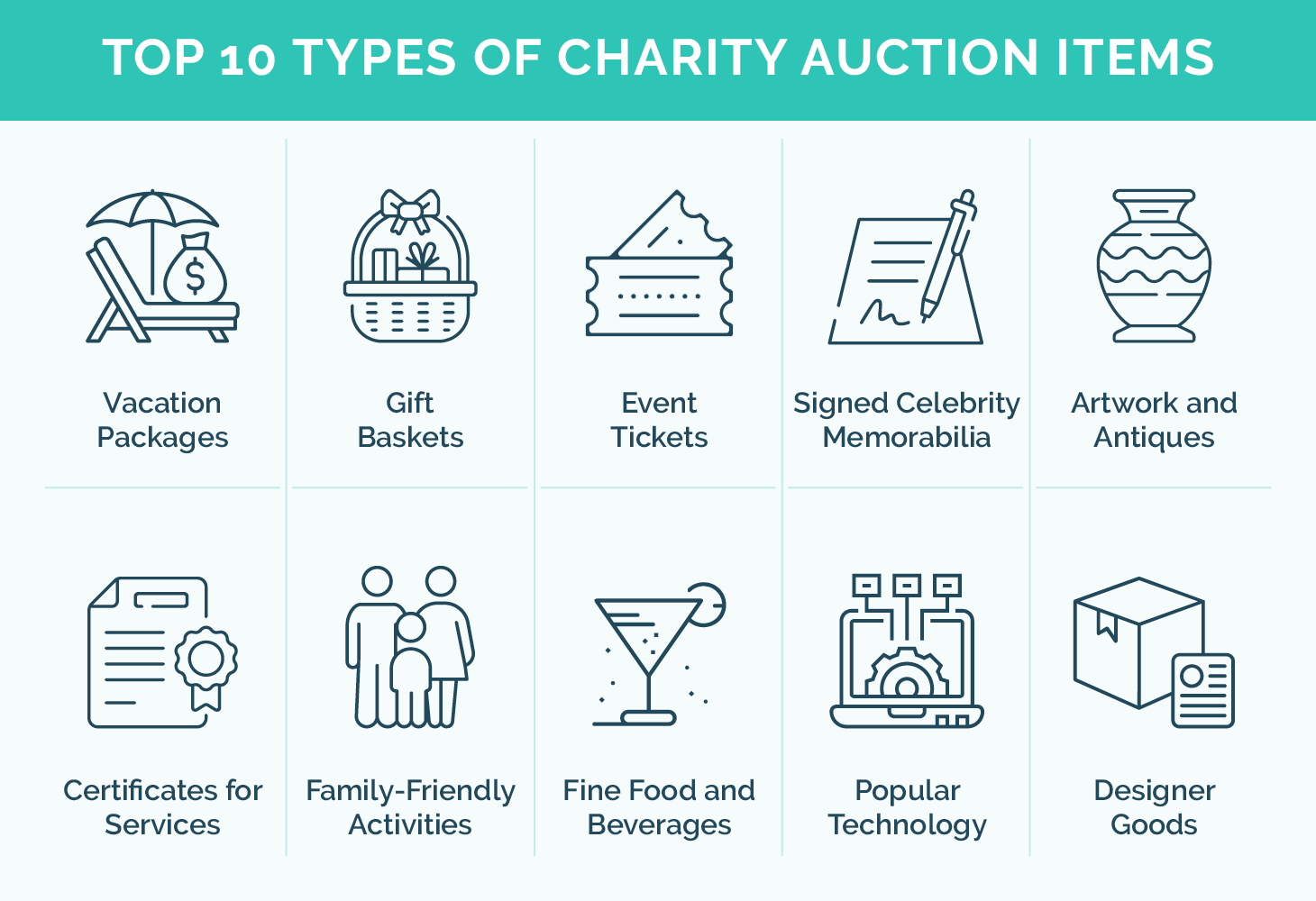
If your nonprofit is planning a silent auction, you’ll need to consider how to get your supporters excited about contributing to your cause at the event. Since most of your fundraising revenue will come from auction item sales, the most important step in accomplishing this is to procure a wide range of high-quality prizes that align with your participants’ interests.
However, the way you display an auction item can make or break whether it attracts competitive bids. After all, supporters will only think about whether and how much to bid on a prize if it first catches their attention!
In this guide, we’ll share four proven tips for making your silent auction displays more engaging to participants, including how to:
- Group Related Items Together
- Make Physical Goods Catch the Bidder’s Eye
- Choose Compelling Photos for Intangible Items
- Incorporate Your Nonprofit’s Branding
Keep in mind that your displays will look different if you’re hosting a virtual auction rather than an in-person event. Instead of arranging all of your items and their paper bid sheets on tables, you’ll need to work within the parameters of your event fundraising software to create digital item descriptions and bid sheets that effectively highlight your prizes. Let’s get started!
1. Group Related Items Together
Before building individual item displays, first plan the overall layout of your auction. The event will be easier for participants to navigate if it’s organized, so categorize your items and create a different section for each category at the venue or in your event software.
Winspire’s guide to the best charity auction items lists 10 types of prizes to procure for nonprofit events, which you can use as a framework to categorize your items:
- Vacation packages
- Gift baskets
- Event tickets (concerts, musicals, athletic events, etc.)
- Signed celebrity memorabilia
- Artwork and antiques
- Certificates for services from local businesses
- Family-friendly activities
- Fine food and beverages
- Popular technology
- Designer goods (which could also be included in a “miscellaneous” category)
Not only does organizing items in this way give your auction a more streamlined and professional feel, but it can also prompt participants to place multiple bids. For example, if a supporter enjoys travel but isn’t set on a particular destination for their next trip, seeing all of your vacation packages in the same area makes it easy for them to bid on several prizes at once.
2. Make Physical Goods Catch the Bidder’s Eye
Once you’ve figured out where to place items within your event layout, your next consideration should be how to arrange each prize on the table. This is especially important for prizes where the tangible item demonstrates its value. Experience-based, intangible prizes and items that would be unwise to place on the table (like gift cards or tickets) also require thoughtful arrangement but the physical item itself is not the main draw.
Some ways to make physical goods stand out on your silent auction tables include:
- Place the highest-value items at the ends of each table. This ensures your big-ticket items are impossible for participants to miss as they pass by. For instance, you might put a new smartphone at one end of your technology table and a video game console at the other end. Then, you could fill in the middle of the table with smaller accessories like Bluetooth headphones and extra controllers.
- Create multi-level displays. To add visual variety to your event layout, purchase clear plastic stands that you can use to elevate featured items while keeping their corresponding bid sheets on the table.
- Make gift baskets look full. Your supporters will perceive your baskets’ value more highly if they look like they’re full to overflowing with prizes rather than having noticeable empty spots. If you don’t have enough items to completely fill a basket, add some colored tissue paper or Easter grass to avoid gaps.
Additionally, include a display sheet that features a catchy title and a one-to-two sentence description of the prize in an upright stand next to each item. This allows participants to quickly get an idea of what each item is before looking at the bid sheet for more information if they’re interested.
3. Choose Compelling Photos for Intangible Items
Display sheets are even more critical for prizes you can’t physically put out on the table, since supporters will rely on them to decide whether to bid. In addition to the title and description, include a few neatly arranged, relevant photos to give supporters a sense of what they’ll experience if they win.
Here are some photo ideas you could display for different types of intangible auction prizes:
- Beautiful views of the destination that the winner of a vacation package will visit.
- People enjoying a delicious meal at a restaurant that provided a gift certificate for your event.
- Smaller versions of the window cards for concerts or musicals you’re auctioning off tickets for.
If you’re hosting a virtual auction, include these photos in your online catalog, which will essentially take the place of your display sheets. Additionally, take and upload at least one high-quality photo of every physical good. Within the catalog, keep your prizes organized and list the highest-value items in each category first to draw more attention to them.
4. Incorporate Your Nonprofit’s Branding
Whether you create physical or digital silent auction displays, make sure to brand all of them to your nonprofit. Branding makes your displays look more professional and serves as a reminder for participants about the cause your auction is supporting.
Make sure to include the following branding elements in your displays:
- Logo. Your nonprofit logo should feature prominently on each display and bid sheet to confirm that they belong to your organization. If your event software allows, incorporate your logo into your auction’s interface so participants can see it throughout the entire bidding process.
- Fonts. Use the same two to three typefaces on all of your display sheets, and ensure they’re readable even from a slight distance.
- Color scheme. If you add color to your display sheets aside from your logo and photos, match the chosen shades to your logo. Also, consider decorating your venue in your organization’s color scheme to further cement the connection between the event and your brand.
- Messaging. According to Loop’s nonprofit branding guide, your brand includes not only the visuals that represent your organization but also the tone and word choice in your written communications. Make sure that all of the writing on your display and bid sheets aligns with your nonprofit’s standards in these areas.
To further emphasize your auction’s impact, include your mission statement and a short blurb about the specific aspect of your work the event will support on your bid sheets. This will help new supporters become familiar with your organization and remind existing donors why the auction is important for your cause.
Throughout your auction, take note of which displays your supporters gravitate toward so you can carry over those effective strategies to your next event. Also, make sure to save a template version of both your display sheet and your bid sheet so you don’t have to start from scratch next time. Happy fundraising!
